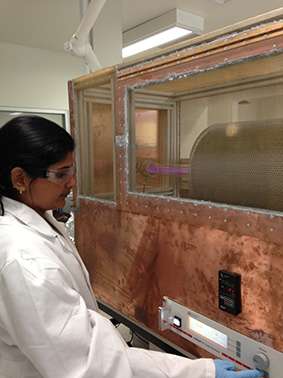Are window blinds the future of power generation?

Imagine a future where you run household appliances with electricity generated by window blinds. Such a future might seem far-fetched, but not to Deakin University PhD student Gayathri Devi Rajmohan.
Ms Rajmohan is working on harnessing the sun's rays through solar panels that are thin and flexible enough to be made into products such as window blinds and backpacks or attached to car roofs. She took the stage at the Geelong Performing Arts Centre recently to distil the essence of her research into a three minute presentation that was engaging and easy to understand as a finalist in Deakin's Three Minute Thesis competition – and won the people's choice award.
Existing solar panels, like the ones seen on roof tops, are rigid, bulky and expensive. An alternative to these panels is the dye-sensitised solar cell that is cheaper, lighter and easier to manufacture and flexible enough to cover many surfaces. However, a number of drawbacks with these cells have prevented them from being commercially available. The main problem, and one that Ms Rajmohan believes she can fix, is the low rate of energy they produce.
"As an alternative method to improve the efficiency of these solar cells, we are exploring an environmentally friendly option – plasma technology," Ms Rajmohan said.
"Plasma, which most people associate with televisions, is a highly energetic gas that carries positive and negative charges that can interact with various materials and change the way they behave. For example, we are using plasma to change the properties of one of the active materials in dye-sensitised solar cells so they can produce more current from the sun."
Dye-sensitised solar cells mimic plants in the way they convert sunlight to energy. Where plants have green pigment in their leaves to capture sunlight and convert it to the energy they need to grow, dye-sensitised solar cells have a red dye that collects the sunlight to generate electricity.
"The red dye in the solar cells is attached to tiny spheres immersed in a liquid. We are applying a plasma treatment to alter the surface of the tiny spheres in order to load more dye and to improve the movement of electrons. This means that more sunlight can be captured and converted to electricity," Ms Rajmohan explained.
"By using this new technology we have started to increase the efficiency of the dye-sensitised solar cell and we believe this is one step closer to seeing our city buildings covered with cheap, flexible and efficient solar panels, so that, just like a rainforest, every bit of sunlight is captured and used without leaving any carbon footprint."
Ms Rajmohan is one of the PhD students working in Deakin's new plasma research laboratory at the University's Geelong Waurn Ponds Campus.
The laboratory is fitted with state-of-the-art, and some unique, equipment that is being used by Deakin scientists to explore the application of plasma in energy, biomedicine, composites, transport and textiles. The projects currently being tackled range from improving the efficiency of solar cells and batteries, through biomaterials, sensors, nanotechnology, light-weight composites and electronic textiles, to anti-pilling of wool knitwear and waste-water treatment.
Provided by Deakin University



















